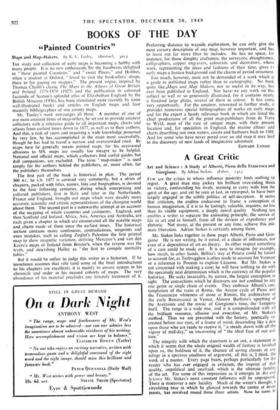A Great Critic
Et:w are the critics in whose influence posterity finds nothing to regret. A great man may jockey his brilliant over-riding thesis to victory, confounding his rivals, seeming to carry with him the spirit of the age, and yet be seen at last, in retrospect, to have been largely engaged in the subtle politics of self-deception. It seems that criticism, the endless endeavour to frame a conception of human imagination, if it is to be lastingly valuable, requires, no less than its visible equipment, a deeply moral quality Nothing less enables a writer to separate the animating principle, the source of life in art and in himself, from all the devices of expediency and rhetoric. Not many, at the present or any time, achieve this inti- mate liberation. Adrian Stokes is certainly among them.
Mr. Stokes links together in these pages Alberti, Piero and Gior- gione. He is not writing, be it noted, of a chain of influences, nor even of a dependence of art on theory. In either respect something of a case could be made out. It is easy to imagine for example, how much, in other hands, Bellini's stay at Pesaro could be forced to account for, as Terbrugghen is often made to account for Vermeer or a reference to Poussin to explain Cazanne. But Mr. Stokes is not concerned with making a case; he will have nothing to do with the speciously neat determinism which is the currency of the popular historian. He seeks invariably, by nature, the largest conception in sight. The connections which he discovers are not confined to any one genre or single chain of events. They embrace Alberti's con- templation of the ruins at Rome, the Arezzo cycle of Piero and the Francescan whiteness of stone at Rimini, the architecture of the early Renaissance in Venice, Almoro Barbaro's upsetting of the Averroists and the music of Giorgione's time, the 'Tempesta itself. The range is a wide one, and it is comprehended with all the brilliant resource, allusive and evocative, of Mr. Stokes's method. Thus we are presented with the history, poetically re- created before our eyes, of a frame of mind, descending like a dew upon those who are ready to receive it, " a steady dawn with all the vigour of mid-day," an uncovering of " the ideal face of our cul- ture."
The integrity with which the statement is set out, a statement in which it seems that the whole original wealth of fantasy is lavished upon us, the boldness of it, the absence of saving clauses or any refuge in a specious smallness of argument, all this is, I think. the work of a master. Every page bears, perhaps particularly for the reader who has ever engaged in criticism, the imprint of that quality, unpolitical and unafraid, which is the ultimate fertility of the art. For some of this impression as it emerges in Art and Science Mr. Stokes's most constant followers will be unprepared. There is moreover a new lucidity Much of the writer's thought. I circulating tour in which he glanced towards the centre at maul points, has revolved round these three artists. Now he turns to meet them face to face, and they are seen unencumbered, in their entirety. There is nothing here of the suggestion, which has compli- cated though it has not marred parts of earlier books, of the manoeuvring of a beautiful but intractable multiple growth through an aperture which remains too small for it. The thought is very accessible, and the result most memorable. No one who reads the pages about Piero, for example, will ever look at, still less write of, the pictures again without these words rising to mind. The lasting impression of criticism of this calibre and this generous cast is one of gratitude, as for a victory won for us. There will be many to share in it, many to enjoy this superbly enjoyable book.
LAWRENCE GOWING.































 Previous page
Previous page